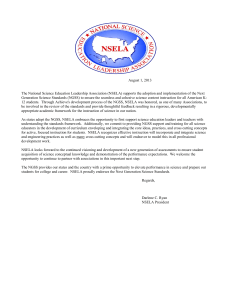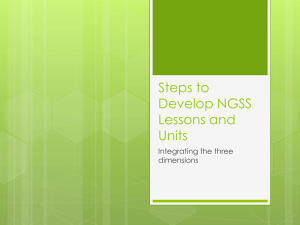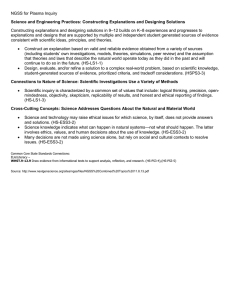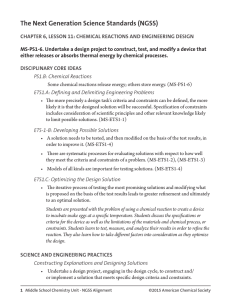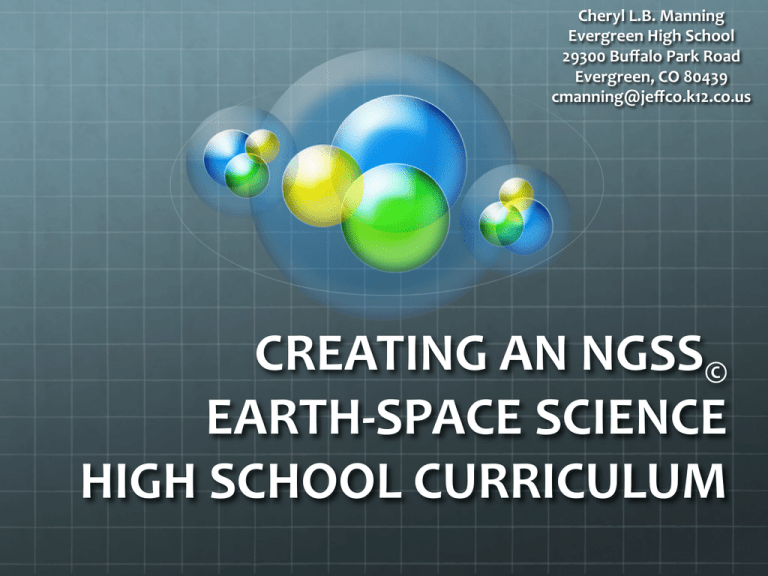
Cheryl L.B. Manning Evergreen High School 29300 Buffalo Park Road Evergreen, CO 80439 cmanning@jeffco.k12.co.us CREATING AN NGSS© EARTH-­‐SPACE SCIENCE HIGH SCHOOL CURRICULUM How NGSS addresses High School Earth & Space Science Differently ! Science and Engineering Practices – SEPs ! Moving away from the classic model of a “Scientific Method” ! Integration of Engineering ! Emphasis on Models, Mathematics, and Communication ! Disciplinary Core Ideas – DCIs ! K-­‐8: Fundamentals of Earth & Space science are being learned ! Coming into high school, students know more but misconceptions are pervasive and are best eliminated through accountable guided inquiry ! Crosscutting Concepts – CCs ! 7 ideas knitting together sciences and engineering fields ! Increase in complexity as students age and develop ! Creating a common language Challenges with Implementing NGSS ! The NGSS is daunting in both organization and depth and breadth ! Finding the connections with what has been done in the classroom and the changes that need to be made ! Making the NGSS work in different settings !
!
!
!
Time, Materials, and Technology Linking NGSS to State Standards and District Curriculum Lack of Administrative Understanding Potential curricular constraints by School Board My Scope & Sequence School district has a defined curriculum to which the NGSS DCIs have to be aligned Autumn Semester ! Processes that influence Earth’s Interior and Exterior ! ESS1.5-­‐6 ! ESS2.1, 2, 3, 5 ! ESS3.1 ! Processes that Impact Life (Resources) ! ESS2.6-­‐7 ! ESS3.1-­‐6* Spring Semester ! Processes that influence the Earth’s Climate ! ESS2.2, 4-­‐7 ! ESS3.3-­‐6* ! Processes that influence the Universe ! ESS1.1-­‐4 *Integration of Engineering My Approach… ! Scissors, Sticky Notes, and String ! Cut apart the DCIs, CCs and SEPs ! Organize them into categories ! Make webs for each unit of study aligning NGSS to District Curriculum ! RESEARCH ! Books & Articles ! Videos ! Peer Collaboration Earth Science SEPs Already Doing Needed to Integrate ! Asking Questions ! Using Models Most of these are the “Engineering” Practices ! Planning & Carrying out Investigations ! Defining Problems ! Analyzing & Interpreting data ! Designing Solutions ! Using Mathematics & Computational Thinking ! Constructing Explanations ! Obtaining, evaluating and communicating information ! Developing Models ! Engaging in Argument from Evidence Defining Problems ! Natural Disaster Earth Systems Science Analysis ! Locating a Research Station in Yellowstone National Park ! Global Tectonic Hazards: How do literacy & poverty affect survival rates in natural disasters (Feedbacks) ! Fires, Flooding, & Water Quality ! Global Climate Summit ! Establishing a Mars Colony Developing & Using Models ! Topographic Map Making & Analysis ! Creating Computer Simulations using NetLogo or Google SketchUp ! Using Computer Simulations such as PhET & EarthObserver ! Physical Models: Topography, Fault-­‐Blocks, Stream Tables, and Groundwater ! Mathematical Models using Excel & Plot.ly Re-­‐thinking the Stream Table Lab ! Students read about recent flooding events ! Identify the factors that contributed to the flooding ! Investigate possible solutions using the stream table ! Develop a research plan ! Test variables, collect data, and analyze results ! Develop & Test possible solutions ! Present best solution & evaluate the solutions designed by other student groups Flowchart by Danski14 (Own work) [CC-­‐BY-­‐SA-­‐3.0 (http://
creativecommons.org/licenses/
by-­‐sa/3.0)], via Wikimedia Commons Designing Solutions to Real Problems ! Representing Topography ! Designing Bridges and Buildings to survive Earthquakes ! Locating a research station in Yellowstone National Park ! Modeling the impacts of Fires, Flooding, & Water Quality – Stream Table ! Water Filtration Project ! Developing Energy Technologies ! Establishing a Mars Colony Filtering Water ! Collaborative Problem-­‐
Solving ! Real-­‐world emphasis on engineering ! Local speakers readily available ! Integration of chemistry and biology ! Cost/Benefit Analysis ! Comparison of natural and designed solutions Engaging in Argument from Evidence ! Natural Disaster Earth Systems Science Analysis ! Analyzing & defending graphed data ! Designing Bridges & Buildings to survive Earthquakes ! Locating a research station in Yellowstone National Park ! Modeling the impacts of Fires, Flooding, & Water Quality – Stream Table/Water Filtration Project ! Global Climate Summit ! Developing Energy Technologies ! Establishing a Mars Colony (cross-­‐curricular with Language Arts) Yellowstone Research Station ! Problem-­‐based Learning ! Collaborative ! Limited time ! Data-­‐driven using files in Google-­‐Earth ! Geothermal Features ! Volcanic History ! Ground Deformation ! Seismicity In Conclusion… ! Get to know all the components of the NGSS ! Science and Engineering Practices ! Disciplinary Core Ideas ! Cross-­‐cutting Concepts ! Identify the strengths and weaknesses of existing curriculum and reach out to others for help ! Use NGSS to strengthen weaknesses and fill in gaps ! Integrate Problem-­‐Based Learning and Technology ! Take risks and try new activities and projects ! Messy, loud, and “controlled chaos” ! Invigorating and fun References Cited !
Climate Literacy & Energy Awareness Network.2014. !
Institute for Global Environmental Strategies. 2014. Earth System Science Education Alliance !
IEEE. 2014. Filtration Investigation. www.tryengineering.org !
SERC. 2014. Resources for Using Google Earth for Geoscience Teaching and Research. On the Cutting Edge. !
Model Diagram. Danski14 (Own work) [CC-­‐BY-­‐SA-­‐3.0 (http://creativecommons.org/
licenses/by-­‐sa/3.0)], via Wikimedia Commons !
NGSS© Lead States. 2013. Next Generation Science Standards: For States, By States. Washington, DC: The National Academies Press !
Thompson, D., West, N., and Olds, S. 2012. Taking the Pulse of Yellowstone’s “Breathing” Volcano. Unavco Geodesy Teaching & Learning Resources. !
USGS Earthquake Hazards Program. !
USGS Volcano Hazards Program Observatories and Centers. © Copyright 2013 Achieve, Inc. All rights reserved. Neither Achieve nor the Lead States and partners have endorsed this presentation.


